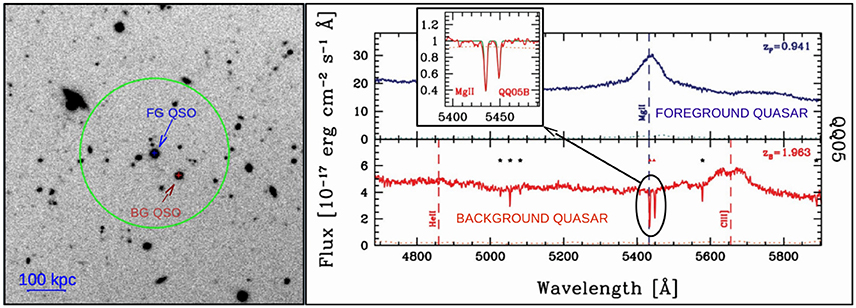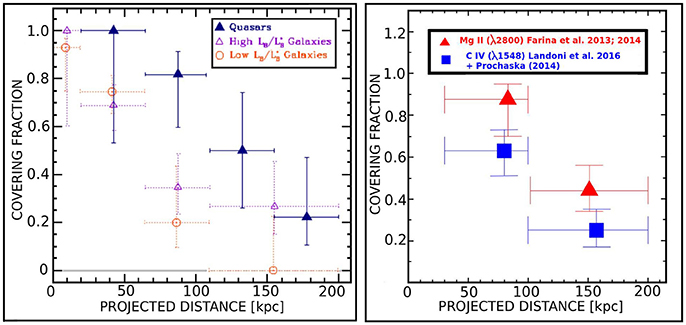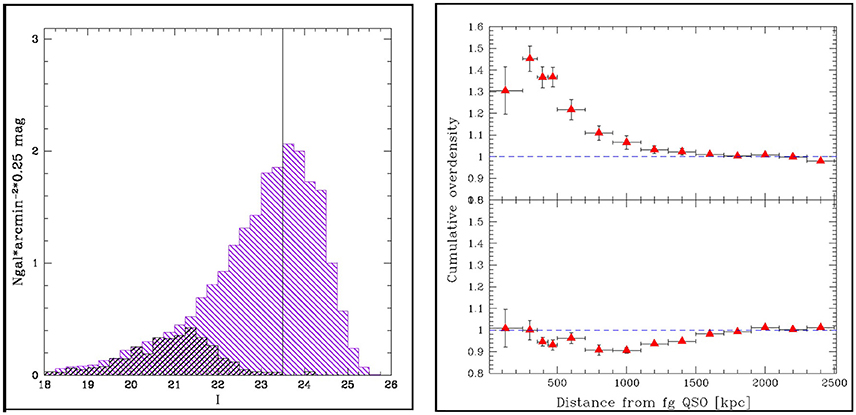Circum-Galactic Medium in the Halo of Quasars
- 1Dipartimento di Scienza e Alta Tecnologia (DISAT), Università degli Studi dell'Insubria, Como, Italy
- 2Osservatorio Astronomico di Padova (INAF), Padua, Italy
- 3Istituto di Astrofisica Spaziale e Fisica Cosmica di Milano (INAF), Milan, Italy
- 4Finnish Centre for Astronomy with ESO (FINCA), University of Turku, Turku, Finland
- 5Instituto de Astrofisica de Canarias, La Laguna, Spain
- 6Max-Planck-Institut für Astronomie, Heidelberg, Germany
The properties of circum-galactic gas in the halo of quasar host galaxies are investigated analyzing Mg II 2800 and C IV 1540 absorption-line systems along the line of sight close to quasars. We used optical spectroscopy of closely aligned pairs of quasars (projected distance ≤ 200 kpc, but at very different redshift) obtained at the VLT and Gran Telescopio Canarias to investigate the distribution of the absorbing gas for a sample of quasars at z ~1. Absorption systems of EW ≥0.3 associated with the foreground quasars are revealed up to 200 kpc from the centre of the host galaxy, showing that the structure of the absorbing gas is patchy with a covering fraction quickly decreasing beyond 100 kpc. In this contribution we use optical and near-IR images obtained at VLT to investigate the relations between the properties of the circum-galactic medium of the host galaxies and of the large scale galaxy environments of the foreground quasars.
1. Introduction
The standard model for the origin of the extreme luminosity of quasars considers that a supermassive black hole shines as a quasar when intense mass inflow takes place, possibly as a consequence of tidal forces in dissipative events (e.g., Di Matteo et al., 2005). In this scenario, the circum-galactic medium of quasar host galaxies is expected to be populated by streams, cool gas clouds and tidal debris, as commonly observed in interacting galaxies (e.g., Sulentic et al., 2001; Cortese et al., 2006). Moreover the gas of the circum-galactic medium could be metal enriched by supernova-driven winds triggered by starbursts events associated to the mergers or by quasar-driven outflows of gas (e.g., Steidel et al., 2010; Shen and Ménard, 2012).
One of the effective ways to study the circum-galactic medium of galaxies at high redshift is to investigate the absorption features that they imprint in the spectra of quasars. In particular, projected quasar pairs (Figure 1 left) are ideal observational tools for this purpose, since the light of the very bright source in the background (z ≡ zB) goes through the extended halo of the foreground (z ≡ zF < zB) object (e.g., Hennawi et al., 2006; Farina et al., 2013). This can be evidenced by absorption lines at the foreground redshift: an example is reported in Figure 1 right.

Figure 1. Left: Image of projected quasar pair Q0059-2702. Blue and red arrows indicate the foreground quasar and the background one. Green circle shows the projected distance of 200 kpc from the foreground quasar. Right: VLT spectra of quasar pair Q0059-2702. The blue and red solid lines refer to foreground quasar and background quasar, respectively. The insert shows the zoom of Mg II absorptions at the same redshift of foreground quasar.
In our previous works we studied 49 quasar pairs (Farina et al., 2013, 2014; Landoni et al., 2016). We used the optical spectroscopy of close pairs (projected distance ≤ 200 kpc) obtained at the ESO-VLT and Gran Telescopio Canarias (GTC) to investigate the distribution of the absorbing gas at 100-200 kpc projected distance from the quasar studying the presence of Mg II or C IV absorption lines at the redshift of foreground quasar. In order to characterize the structure of circum-galactic medium of the foreground quasar host galaxy we estimated the covering fraction of Mg II or C IV as a function of the projected distance. We assumed a threshold in equivalent width of 0.3, then we subdivided the projected distance in bins. For each bin we computed the covering fraction as the ratio between the number of systems with Mg II or C IV absorption lines greater than the threshold and the total number of observed systems. Our previous results (Farina et al., 2013, 2014; Landoni et al., 2016) indicate that 22 spectra exhibit absorption lines of foreground quasar in the background quasar: 15 Mg II and 7 C IV. We found that the detected Mg II absorption systems of EW >0.3 Å associated with the foreground quasars are revealed up to ~200 kpc from the centre of the host galaxy. The structure of absorbing gas is patchy with covering fraction of the gas that quickly decreases beyond 100 kpc. This is illustrated in Figure 2 left. A similar behavior is present in absorption systems with C IV doublet (Figure 2 right).

Figure 2. Left: Comparison between quasars (Farina et al., 2014) and galaxies (Nielsen et al., 2013) of covering fraction of transversal absorption system of Mg II as a function of the projected distance. Right: Comparison of covering fraction of quasar halo for Mg II (red triangles) and C IV (blue squares) absorption lines. The covering fraction of Mg II is systematically higher than that of C IV.
In this paper we analyze optical and NIR images of foreground quasars in order to investigated their closed environments and their host galaxies.
2. Sample and Observations
The selection procedure of our quasar pair projected sample is reported in detail in Farina et al. (2013) and Farina et al. (2014). Here we summarize briefly the main criteria of our choice:
(i) visibility from telescope location;
(ii) foreground quasar redshift must be selected in order that Mg II doublet falls in GRISM wavelength range;
(iii) projected distance at foreground
redshift ≤ 200 kpc;
(iv) line-of-sight velocity difference ≥5,000 km s−1 to avoid physical pairs;
(v) background quasar must be brighter than mV ~ 21 to ensure good spectra signal-to-noise ratio.
We acquired optical images at FORS2@VLT with the I BESS filter for the object with z ≤ 1 and the Z GUNN filter otherwise, and near-IR images at HAWK-I@VLT with H filter for a total of 24 quasar projected pairs (4 targets have only optical images, 8 ones have only NIR images and 12 objects have images in both bands.). With this configuration we explore galaxies at the redshift of the target in the B band in the rest frame. For a subsample of object reported in Table 1 we present here 8 deep high quality I-band images (seeing ~0.5 arcsec).
3. Analysis
We performed the analysis of optical images in order to characterize the close environment of foreground quasar. We used the software SEXTRACTOR (Bertin and Arnouts, 1996) to identify all objects in the frame over a given magnitude limit and to distinguish galaxy-like objects from star-like ones (galaxies have CLASS_STAR < 0.5 and stars have CLASS_STAR >0.5). Then we evaluated the overdensity of galaxies around the foreground quasar calculating the ratio of number of galaxies per arcminute square to background estimated at distances greater than 500 kpc.
The near-IR images have been analyzed using the software package AIDA (Astronomical Image Decomposition Analysis, Uslenghi and Falomo, 2008). From this analysis of the near-IR images we are able to characterize the properties of the foreground quasars host galaxy via 2-d model fitting, assuming that they are the result of the superposition of two components: the nucleus, described by the local PSF, and the host galaxy, modeled by a Sersic function convolved with the proper PSF.
4. Preliminary Results
Based on our deep optical images of quasars we are able to characterize the galaxy environment up to I ~ 23.5 which is more than 2 magnitudes deeper than SDSS images (see Figure 3 left). This allows to investigate the galaxy environment down to about 3 magnitude fainter than M*. We find that for 4 cases there is a clear galaxy overdensity around the foreground quasar while in the another 4 cases there is no evidence that quasars live in a group of galaxies (see Figure 3 and Table 1). In 3 quasars that exhibit overdensity there is also a detection of Mg II absorption systems at the same redshift of foreground quasar in the circum-galactic medium. In the cases of no galaxy overdensity Mg II absorption lines are detected in 2 objects. The small sample, investigated till now, does not permit us to draw firm conclusions on the relationship between galaxy environments and presence of cold gas in the intergalactic medium. We are completing the analysis of the full sample and extending it with other targets from ongoing observations at GTC.

Figure 3. Left: Average surface number density of galaxies vs. I magnitude of 8 quasar pair fields obtained at VLT FORS2. The vertical line marks the adopted threshold magnitude for the environment study. For comparison the black histogram shows the similar distribution based on the SDSS analysis of 5 fields. Right: Average cumulative overdensity of galaxies around quasars (see Table 1). Only half of quasars exhibits a clear galaxy overdensity (upper panel) while the other half does not show any overdensity (lower panel).
Till now we analyzed 11 out of the 20 foreground quasars with NIR images. For 9 (~80%) the host galaxy is well resolved. In one case the detection of the host galaxy is marginal and only for one image no evidence of the host galaxy is found. The rest frame absolute magnitude in I band of the resolved host galaxies ranges from −22.5 to −24.9, with a median value of −23.7. These results are comparable to those reference to other quasars at similar redshift (Sanghvi et al., 2014).
Author Contributions
RO provides the analysis of the environment. MU provides the analysis of NIR images. All other authors provide discussion of results and write the paper.
Conflict of Interest Statement
The authors declare that the research was conducted in the absence of any commercial or financial relationships that could be construed as a potential conflict of interest.
Acknowledgments
EF acknowledge funding through the ERC grant “Cosmic Dawn.”
References
Bertin, E., and Arnouts, S. (1996). SExtractor: software for source extraction. Astron. Astrophys. Suppl. 117, 393–404. doi: 10.1051/aas:1996164.
Cortese, L., Gavazzi, G., Boselli, A., Franzetti, P., Kennicutt, R. C., O'Neil, K., et al. (2006). Witnessing galaxy preprocessing in the local Universe: the case of a star-bursting group falling into Abell 1367. Astron. Astrophys. 453, 847–861. doi: 10.1051/0004-6361:20064873
Di Matteo, T., Springel, V., and Hernquist, L. (2005). Energy input from quasars regulates the growth and activity of black holes and their host galaxies. Nature 433, 604–607. doi: 10.1038/nature03335
Farina, E. P., Falomo, R., Decarli, R., Treves, A., and Kotilainen, J. K. (2013). On the cool gaseous haloes of quasars. Month. Notices R. Astron. Soc. 429, 1267–1277. doi: 10.1093/mnras/sts410
Farina, E. P., Falomo, R., Scarpa, R., Decarli, R., Treves, A., and Kotilainen, J. K. (2014). The extent of the Mg II absorbing circumgalactic medium of quasars. Month. Notices R. Astron. Soc. 441, 886–899. doi: 10.1093/mnras/stu585
Hennawi, J. F., Prochaska, J. X., Burles, S., Strauss, M. A., Richards, G. T., Schlegel, D. J., et al. (2006). Quasars probing quasars. I. optically thick absorbers near luminous quasars. Astrophys. J. 651, 61–83. doi: 10.1086/507069
Landoni, M., Falomo, R., Treves, A., Scarpa, R., and Farina, E. P. (2016). Circumgalactic medium of quasars: C IV absorption systems. Month. Notices R. Astron. Soc. 457, 267–271. doi: 10.1093/mnras/stv2964
Nielsen, N. M., Churchill, C. W., and Kacprzak, G. G. (2013). MAGIICAT II. General characteristics of the Mg II absorbing circumgalactic medium. Astrophys. J. 776:115. doi: 10.1088/0004-637X/776/2/115
Sanghvi, J., Kotilainen, J. K., Falomo, R., Decarli, R., Karhunen, K., and Uslenghi, M. (2014). The black hole-host galaxy relation for very low mass quasars. Month. Notices R. Astron. Soc. 445, 1261–1268. doi: 10.1093/mnras/stu1822
Shen, Y., and Ménard, B. (2012). On the link between associated Mg II absorbers and star formation in quasar hosts. Astrophys. J. 748:131. doi: 10.1088/0004-637X/748/2/131
Steidel, C. C., Erb, D. K., Shapley, A. E., Pettini, M., Reddy, N., Bogosavljević, M., et al. (2010). The structure and kinematics of the circumgalactic medium from Far-ultraviolet spectra of z ˜ = 2–3 galaxies. Astrophys. J. 717, 289–322. doi: 10.1088/0004-637X/717/1/289
Sulentic, J. W., Rosado, M., Dultzin-Hacyan, D., Verdes-Montenegro, L., Trinchieri, G., Xu, C., et al. (2001). A multiwavelength study of stephan's quintet. Astron. J. 122, 2993–3016. doi: 10.1086/324455
Keywords: quasar, quasar environment, quasar pair, quasar spectra, galaxy around quasar
Citation: Ottolina R, Falomo R, Treves A, Uslenghi M, Kotilainen JK, Scarpa R and Farina EP (2017) Circum-Galactic Medium in the Halo of Quasars. Front. Astron. Space Sci. 4:61. doi: 10.3389/fspas.2017.00061
Received: 28 September 2017; Accepted: 04 December 2017;
Published: 21 December 2017.
Edited by:
Mauro D'Onofrio, Università degli Studi di Padova, ItalyReviewed by:
José María Solanes, University of Barcelona, SpainAscensión Del Olmo, Instituto de Astrofísica de Andalucía (CSIC), Spain
Fabio La Franca, Università degli Studi Roma Tre, Italy
Copyright © 2017 Ottolina, Falomo, Treves, Uslenghi, Kotilainen, Scarpa and Farina. This is an open-access article distributed under the terms of the Creative Commons Attribution License (CC BY). The use, distribution or reproduction in other forums is permitted, provided the original author(s) or licensor are credited and that the original publication in this journal is cited, in accordance with accepted academic practice. No use, distribution or reproduction is permitted which does not comply with these terms.
*Correspondence: Riccardo Ottolina, r.ottolina@uninsubria.it
 Riccardo Ottolina
Riccardo Ottolina Renato Falomo2
Renato Falomo2  Jari K. Kotilainen
Jari K. Kotilainen Riccardo Scarpa
Riccardo Scarpa Emanuele Paolo Farina
Emanuele Paolo Farina